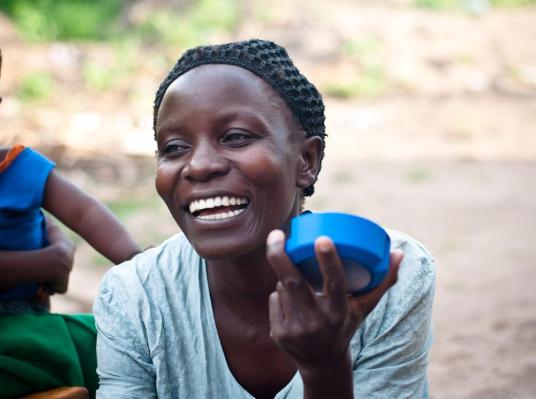Often, off-grid rural villages in places like Africa have their electricity generated by energy devices, like solar panels and batteries, donated by non-profit organizations and charities. The problem, however is that model is not sustainable and relies of yet more charitable hand-outs. What’s required is to make clean energy scale in self-supporting way. Luckily the rise of the mobile phone and mobile money (such as M-PESA) has created a whole new industry which could allow clean energy to be paid-for by customers in developing countries in a manner where they can actually afford it.
A San Francisco startup called Angaza has come up with an innovative business model which employs a Pay-As-You-Go (PAYG) system which it combines with clean energy. It’s now closed a Series A funding of $4 million, following its $1.5 million Seed round in 2013 to address the 1.2 billion people who currently live off the grid. The round was led by an unnamed US-based family office and was joined by New York-based The Social Entrepreneurs Fund and several others.
Most of the 1.2 billion people on the planet without electricity don’t have enough ready cash at one time to purchase a solar light or energy system outright and are therefore stuck in a perpetual cycle, having to spend up to 20% of their income to buy kerosene fuel to burn for light at night. PAYG allows off-grid families the opportunity to buy clean, reliable electricity in small, affordable increments. Angaza partners with manufacturers and distributors to provide them with a B2B PAYG solution.
Here’s how it works: Take someone in rural Kenya. They typically first learn about the possibility of purchasing a solar lantern through a local sales agent of one of Angaza’s distribution partners. After making a small “down payment” for the device ($1-5), they take the lantern (often with a mobile phone charging port) and solar panel home. The lantern will stay on for an amount of time proportional to the size of the payment that was made. After that amount of time has elapsed, the device deactivates and cannot be turned on again until another payment is made, just like buying pre-paid airtime on a mobile phone. They can then use the money in their mobile wallet to send a payment from their phone to the distribution company that sold them the lantern. The user can then continue to make weekly payments of $1-2 each until the lantern is fully paid for, typically in inside two to 12 months, depending on the size of the product.
This is in effect a magic bullet: It means sustainable solar energy for the customer, which they can pay off, ends their reliance on kerosene (which is massively polluting to the environment and a health hazard), and its also makes for a business model which doesn’t require yet more charitable donations. It also means distribution partners can see a four-to-five-fold increase in sales when they begin to offer PAYG, because the customers can actually afford to pay in these small increments via their mobiles. Boom!
Angaza’s solution consists of embedding a hardware subcircuit and firmware into a solar or other green energy device which provides both internal energy metering, so the device can deactivate if the pre-paid energy has been consumed; and a mobile wireless connection, so payment information can be sent to the unit, from which usage and diagnostic information can be remotely collected. The technology is integrated into clean energy devices to allow these devices to be paid for over time, in small increments.
The startup earns recurring revenue (a percentage of the transaction fees) off of every payment that is processed by its software platform. It also collects licensing fees from manufacturing partners who use its embedded technology.
And make no mistake, this is a big market. According to the Global Off-Grid Lighting Association (GOGLA) expects the off-grid energy and appliance market to be a $50 billion per year opportunity.
Angaza is the only company that offers a PAYG solution for even the smallest, ½-watt clean energy devices.
So far, distributors use Angaza’s platform to sell Pay-As-You-Go energy devices in Kenya, Tanzania, Uganda, Malawi, Zambia, South Africa, India, and Pakistan.
While there are several other Pay-As-You-Go solar companies focused on the East Africa and Indian markets, they have taken a completely vertically integrated approach (e.g. M-KOPA and Off Grid Electric). This means that they manufacture their own product, build their own PAYG technology, distribute their products to end users, and provide after-sales support. But Angaza can sell to third-party manufacturers at a fraction of the cost it would take for them to develop it in-house, while leveraging Angaza’s existing traction and scale. Other companies, like Kingo, have chosen an end-to-end solution where they sell their devices AND the PAYG service in one platform, but must therefore rely on their own ability to scale.
The executive team comprises Lesley Marincola (CEO), Bryan Silverthorn (CTO) (who are brother and sister) and Victoria Arch (VP of Global Strategy). Its ten person San Francisco office includes primarily hardware and software engineers as well as a small business team. Its three person Nairobi office focuses on fostering partnerships with PAYG distributors.
Prior to founding Angaza, Marincola completed her B.S. and M.S. in Product Design and Mechanical Engineering at Stanford and worked at Amazon (Lab126) on the Amazon Kindle design team.
